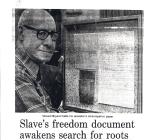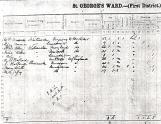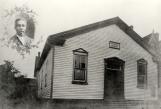1
According to Richard Butler in Saturday Musings, a series of weekly articles from the Spectator, the earliest African presence in Hamilton was that of "apprenticed slaves." Blacks were bound to their masters but were protected from injustice and cruelty. Butler's description was probably an attempt to place Canadian slavery in a more favourable light. After Lieutenant-Governor Simcoe's 1793 Proclamation which banned the further importation of slaves into Upper Canada, most early Blacks were escaped slaves who began to migrate to the city in the early 1800s. By the 1850s, there was a distinct community known as "Little Africa." The nucleus of Little Africa was formed by several Black families who were granted lots by landowner William Bridge Green on Hamilton Mountain. Their names were William Nelson, George Washington, Isaac Davis, Washington Scott, Henry Johnson, Lewis Miles Johnson, Edward Johnson, David Nelson and William Jaggard.3
This 1861 census record shows several Black families living together in a one-storey house in St. George's Ward, Hamilton. William Munro, 53-year-old whitewasher (painter) and widower lived with his nine-year-old daughter Lizzy. Mr. Munro hailed from Virginia, USA and his daughter was born in Canada West (Ontario). Fellow whitewasher Elias Allen and his wife Julia, ages 26 and 21, hailed from Maryland and New York, respectively. A.E. Ballard, 38, and her husband, I. Ballard, a 44 year-old shoemaker, were listed with 64-year-old widow Mary Smith and 19-year-old M.A. Jeffry. Mr. Ballard, Mary Smith and Ms. Jeffry were born in Pennsylvania, USA. Mrs. Ballard was born in the West Indies. The Munros and Allens worshipped in the Wesleyan Methodist faith, probably at St. Paul's AME which later became Stewart Memorial. The Ballards, Mary Smith and Miss Jeffry practised their religion with the Church of England. Census documents such as this provide a wealth of information about its residents and reveal the kinds of kinship arrangements and extended families that were common in 19th century Ontario.4
Vince Bryant looking at Freedom papers of Abram Bryant, 1831.1980
Hamilton, Ontario, Canada
 Credits:
Credits:Courtesy of Corinne Bryant Chevalier.
5
One of the families who migrated to Hamilton during this time was that of Abram Bryant. Abram was a slave in Tennessee who received his freedom papers in 1831 and moved to Buffalo, New York. He married Eliza Dixon in 1837 in Buffalo and between 1837 and 1844 moved to Hamilton, Upper Canada. One of his three children, Violet Ann Bryant was born in Hamilton in 1844. The records still kept by his descendants don't tell us what occupations he held, but the family has remained in Hamilton for several generations and contributed to Hamilton's development in a variety of ways.6
These early families farmed, owned businesses and were employed in a variety of occupations, both skilled and unskilled. By 1861, there were 476 persons listed as "Coloured" or "Mulatto" in the Hamilton census. H. F. Gardiner remembered that when he came to Hamilton in about 1870, most of the barbers were Black and there were Black waiters in some of the hotels. The 1871 census tells us that Black men also worked as tobacconists, plasterers, shoemakers, cooks, innkeepers, stonemasons, carpenters, painters, peddlers and saw sharpeners. Black women worked as domestic servants, washerwomen, cooks, dressmakers, seamstresses, teachers and grocers. Gardiner noted that there were two Black churches, located on McNab and Rebecca Streets, with large congregations, and that many Blacks resided within close proximity to their church. The church on McNab was actually a Baptist church. It was established by Elder Christian Washington, the father of the Black Baptist movement in Ontario. This church was founded in 1847.8
The church on Rebecca, of course, was the original location of Stewart Memorial. As already mentioned, Stewart Memorial was founded in 1835 under the auspices of the African Methodist Episcopal body established in 1816 in the United States. Reverend Richard Allen is considered the father of the AME Church. Because of discrimination, he and other Black parishioners split with the white methodists in Philadelphia and established the Bethel African Methodist Church in 1792. This denomination grew rapidly and soon established churches across the United States, as well as foreign missions, a publishing wing and numerous churches in Canada West (Ontario). In the 1990s, the AME included over 2,000,000 members, 8000 ministers, and 7000 congregations in more than 30 nations in North and South America, Africa, and Europe. Twenty bishops and 12 general officers comprised the leadership of the denomination.9
Published address on slavery by Paola Brown at the Hamilton City Hall on February 7, 1851.1851
Hamilton, Ontario, Canada

10
As elsewhere, African Canadians in Hamilton organized protests against racism and discrimination, participated in Emancipation Day celebrations on the first of August every year and sent men south to fight for the Union Army during the American Civil War. One of the biggest issues for African Canadians in the mid-1800s was the fact that their children were barred from the public schools that white children attended. Paola Brown, the city bellman and town crier, led the charge for integrated schools. For a time he was the unofficial leader of the Black community in Hamilton. In 1843, Brown and the Black residents signed and sent the following petition to the Governor General, Lord Elgin:"We the people of colour in the Town of Hamilton have a right to inform Your Excellency of the treatment that we have to undergo.
We have paid the taxes and we are denied of the public schools, and we have applied to the Board of the Police and there is no steps taken to change this manner of treatment, and this kind of treatment is not in the United States for the children of colour go to the Public Schools together with the white children more especially in Philadelphia. And I thought there was not a man to be known by his colour under the British Flag….
We are called nigger when we go out in the street, and sometimes brick bats is sent after us as we pass in the street. We are not all absconders now we brought money into this Province, and we hope never to leave it, for we hope to enjoy rights in this Province…"
The Board of Police refused to yield to the prejudice of white parents and enforced the law that Black children be allowed to go to school with white children. Consequently, for a time, Black children attended the common schools in Hamilton.

